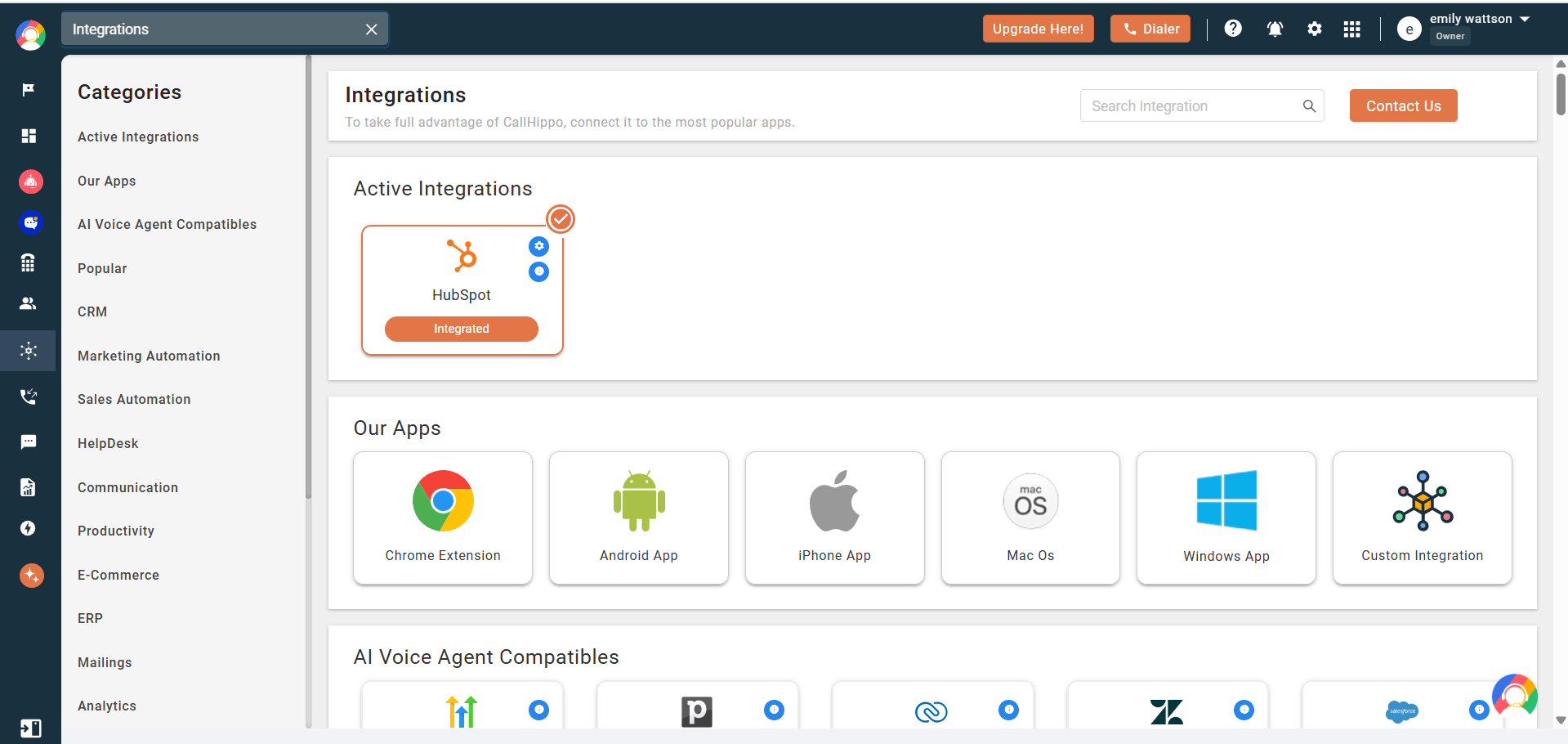According to a report, the global market for cloud telephony services has experienced a rapid surge, from $31.88 billion in 2024 to $37.49 billion in 2025. The growth has been substantial.
This move suggests that businesses are rapidly shifting towards cloud telephony from old-school traditional business phone systems.
This shift also allows businesses to effectively support their remote teams and hybrid environments.
In this blog, we’ll walk you through each and every aspect related to cloud telephony. From what is cloud telephony to its industry-specific applications.
What is Cloud Telephony?
Cloud telephony, also known as a cloud phone system, refers to a phone system that is hosted and delivered over the internet. As it is hosted on the provider’s servers, it’s ideal for businesses wanting a sophisticated setup. Cloud telephony eliminates the need for a high-end in-house tech infrastructure.
Analyze the top 3 to 5 call reasons. Once analyzed, you can create your own routing logic. This can let you reduce wait time for your callers and enhance their experience.
How Does Cloud Telephony Work?
When using a cloud telephony service, the messages and calls travel over the internet and not a copper line.
Here’s a step-by-step overview of how cloud telephony operates.
Step 1: Call initiation: When making inbound and outbound calls, the voice data travels through the internet instead of copper wires.
Step 2: Server management: The cloud telephony provider’s servers handle call routing, voicemail, and auto attendants.
Step 3: Access: Users connect using softphones, mobile apps, or desk phones, whichever suits their setup.
Step 4: System operations: The system automatically handles number provisioning, call switching, and integrations with CRM (Customer Relationship Management) or other business tools.
Key Features of Cloud Telephony
Cloud telephony is widely adopted by businesses due to its extensive feature range. This allows companies to boost productivity and empower growth simultaneously.
Here are a few key features of cloud telephony.
1) Call Routing and Auto Attendants
The inbound calls are automatically diverted to the right person/team by CallHippo. This reduces the need for human intervention and frees your team from manual workload.
Also, the callers can be greeted via auto attendants. They can even route the callers with a step-by-step menu.

2) Integration with Other Software (CRM, Helpdesk)
One of the big advantages of cloud telephony is its smooth integration. You can link your system to CRM, helpdesk, marketing automation platforms, chatbots, or ticketing systems.
That means calls become actionable records, increasing insight and efficiency.

3) Scalability and Flexibility
With a business phone system, you can add or remove phone lines, users, and features as per your requirements.
Also, the need for extensive expenditure on hardware is not necessary. And you can still effectively support your remote or global offices.
Benefits of Cloud Telephony
Look for a cloud telephony system that goes beyond just good business communication. Here’s a list of benefits that you can gain by using a cloud telephony system.
1) Cost Savings with Cloud Telephony
By moving to cloud telephony services, you eliminate much of the upfront capital expenditure on phone hardware.
Best cloud telephony service providers offer flexible pricing options. This way, you can opt for a model that aligns with your specific business requirements.
- The cost of cloud telephony is anticipated to drop by approximately 3% to 5% each year. This makes it one of the most affordable options to manage international communications.
2) Increased Flexibility and Mobility
Make/receive calls with ease from anywhere and at any time with cloud telephony. You can even make calls via mobile apps or from the comfort of your home.
This is the level of convenience you avail by utilizing cloud telephony. This is especially helpful if your teams operate in a hybrid/remote working model.
3) Enhanced Customer Experience and Business Communication
Cloud telephony service’s stand-out features, such as intelligent routing, CRM integration, analytics, etc., significantly improve the customer engagement rate.
Quick response, smart escalations, and high-quality data are a few factors that lead to better interactions and consistent service.
Key Differences: Cloud Telephony VS VoIP Technology
While both Cloud Telephony and VoIP enable voice communication over the internet, they differ significantly. Here are the key differences.
| Feature | Cloud Telephony | VoIP Technology |
|---|---|---|
To put it in a nutshell, even though cloud telephony and VoIP utilize the internet connection to deliver calls and messages via digital data packets, cloud telephony relies heavily on hosted infrastructure.
It integrates features and scalability in a much better way than many traditional VoIP systems.
Challenges in Cloud Telephony Adoption
Cloud telephony offers numerous advantages, but it is essential to recognize that you may encounter a few challenges in the initial stages.
Here is a look at some of the challenges that you might face when adopting cloud telephony.
1) Integration with Existing Communication Systems
If an organisation has traditional PBX systems, fax systems, or any existing business phone service, migrating to cloud telephony can become complex.
Mapping number ranges, routing rules, and extensions takes planning. You may need hybrid modes for some time while you transition.
2) Downtime and Service Reliability Concerns
Although cloud telephony providers advertise high availability, your service still depends on internet connectivity and the provider’s infrastructure.
Service disruptions can impact the quality of voice calls, call continuity, or failover. It’s critical to check SLAs, redundancy, and fail-safe mechanisms.
3) User Training and Adoption Barriers
To use a new system to its full potential, your team must adapt to it. Lack of knowledge or inadequate training can lead to underwhelming results.
Therefore, you must ensure that your team receives proper training on how to effectively utilize cloud telephony services.
4) Managing Scalability and Performance
With the growing expansion of users, calls, etc., you’ll need to ensure the system scales as well.
Without a proper strategy in place, you may experience dropped calls or service quality issues.
5) Vendor Lock-in and Limited Flexibility
Some cloud telephony providers lock you into proprietary platforms, custom code, or add-on modules that make it hard to switch later.
You may find you’re tied to a pricing tier or set of integrations. Evaluating portability, API access, and exit strategy upfront helps mitigate this risk.
Best Cloud Telephony Service Provider
Here are some leading cloud telephony providers in 2025, shortlisted for you to make a quick comparison and informed decision-making.
| Tool | Best For | Trial Info | Price | ||
|---|---|---|---|---|---|
| 1 | CallHippo | An all-in-one, cost-effective solution for small and medium-sized businesses. Offers a free plan option. | 10-day free trial | $19 per user/month | Try For Free |
| 2 | RingCentral | A feature-rich and customizable solution for all business sizes. | 14-day free trial | $20 per user/month | Explore More |
| 3 | Grasshopper | For businesses that need an easy-to-use setup without managing complex infrastructure. | 7-day free trial | $14/account | Explore More |
| 4 | Nextiva | A solution for businesses looking for enhanced cloud communication and analytics. | No free trial available | $52/user/month | Explore More |
| 5 | Ringover | An easy-to-use solution with multilingual support and smooth integration. | 7-day free trial | $21/user/month | Explore More |
| 6 | 8x8 | A unified communications platform that is more valued for large-scale customer service. | 30-day free trial | Contact for More Details | Explore More |
| 7 | Dialpad | AI voice intelligence to assist sales and support teams. Best for small to mid-sized businesses. | 14-day free trial | $15/user/month | Explore More |
| 8 | Vonage | A solution with tailored voice and messaging workflows. Built for businesses wanting a highly customizable setup. | 14-day free trial for some plans | $13.99 per month/per line | Explore More |
1) CallHippo
CallHippo is one of the globally acclaimed cloud telephony providers. It offers virtual numbers, a unified communications dashboard, browser-based calling, and much more. Its easy integration with CRMs is what makes it stand out. The platform is quick to deploy and requires no complex setup, making it ideal for businesses seeking a flexible, reliable, and cost-efficient cloud telephony service.
Pros
- Quick, no-code setup for small teams and startups.
- Excellent CRM integration and browser-based softphone interface.
- Affordable pricing with global virtual numbers in 50+ countries.
- Compliant with global regulations such as HIPAA, GDPR, and SOC 2.
Cons
- Advanced analytics and AI call insights are limited.
- Lacks deeper compliance tools for highly regulated industries.
- Customization options are fewer than those of enterprise-grade systems.
Key Features
- Auto Attendant / IVR
- Power Dialer
- Smart DID routing
- Answering machine detection
- Smart call forwarding
- Unified communications
Pricing
- Basic: $0 per user/Month
- Starter: $19 per user/Month
- Professional: $29 per user/Month (Popular)
- Ultimate: $45 per user/Month

Experience the capabilities of CallHippo without any commitment.
2) RingCentral
RingCentral, an enterprise-grade cloud telephony provider that supports voice, video, instant messaging, and collaboration. It is known for its reliability and enterprise security. RingCentral excels in supporting global teams with advanced collaboration features.
Pros
- Reliable infrastructure with 99.999% uptime SLA.
- Comprehensive (voice, video, instant messaging) ecosystem.
- Strong reliability and enterprise-grade security
Cons
- Pricing can deter smaller companies.
- Interface has a steeper learning curve.
- Customisation often requires IT involvement.
Key Features
- Interactive Virtual Response (IVR)
- Automatic Call Recording
- Voicemail-to-Email
- Business SMS
- Call Flip
- Background Noise Reduction
Pricing
- Core: $20 per user/Month
- Advanced: $25 per user/Month
- Ultra: $35 per user/Month
- Customer engagement bundle: (Contact for More Details)
3) Grasshopper
Grasshopper solves the need for a professional phone presence without having to manage complex infrastructure. It mainly focuses on serving entrepreneurs and small businesses. Grasshopper’s simplicity and its easy-to-use setup are its biggest strengths.
Pros
- Easy-to-use setup which makes it ideal for micro-businesses.
- Works on mobile, making remote management easy.
Cons
- Lacks reporting and analytics capabilities.
- Limited CRM or help-desk integrations.
- No international number support for some regions.
Key features
- Call Forwarding
- Porting an Existing Number
- Setup Assistant
- VoIP & Wifi Calling
- Business Texting
- Call Tracking & Analytics
Pricing
- True Solo: $14/account
- Solo plus: $25/account
- Small Business: $55/account
4) Nextiva
Nextiva is a customized cloud telephony solution for integrated cloud communication and analytics. It connects VoIP, CRM, and team collaboration into one platform. Nextiva offers great support, appealing to growing enterprises.
Pros
- Analytics and call-tracking features.
- Uptime and a 24/7 support team.
Cons
- Some advanced modules are locked behind premium plans.
- A mobile app can lag with heavy concurrent users.
- Integration setup requires initial training for staff.
Key Features
- Auto Attendant
- Barge-in
- Call Flow Builder
- Call Forwarding
- Call Queue
- Call Recording
Pricing
- Core: $52 /user/month
- Engage: $38 /user/month
- Power Suite: $100 /user/month (Up to 100 Agents)
5) Ringover
Ringover emphasizes team collaboration. Its flexible and feature-rich cloud telephony services offer multilingual support, ease of use, and smooth integration with business apps. Designed for teams that operate across time zones, Ringover simplifies global communication.
Pros
- International coverage for businesses looking to expand globally.
- Intuitive interface supporting multiple devices.
- Easy integration to boost productivity and efficiency.
Cons:
- Fewer third-party integrations compared to larger platforms.
- Customer support response can vary by region.
- Limited advanced AI analytics in lower tiers.
Key Features
- Click to Call
- Power Dialer
- Parallel Dialer
- Interactive Virtual Response (IVR)
- Time-based Routing
- Professional Greeting
Pricing
- Smart: $21/User/month
- Business: $44/User/month
- Advanced: (Contact for More Details)
6) 8×8
8×8 is a global provider of hosted cloud telephony. It offers voice, video, and contact-centre solutions for enterprises. Built for scalability, 8×8 has tools that are particularly valued in large customer-service environments.
Pros
- Analytics and AI-based speech insights.
- Compliance (ISO 27001, GDPR, HIPAA) for regulated industries.
- Scalable solution for businesses operating with large customer-service requirements.
Cons:
- Complex configuration for smaller teams.
- Contact-centre features raise the overall cost.
- Steep learning curve for non-tech users.
Key Features
- Video Conferencing
- Auto Attendant
- International Calling
- Proactive Messaging
- Mobile Screen Sharing
- Access Voicemails
Pricing
- Offers multiple plans (Contact for More Details)
7) Dialpad
Dialpad focuses more on AI voice intelligence and smart routing to help sales and support teams. It combines telephony with AI to deliver smarter communications and real-time transcription.
Pros
- AI insights for enhanced call quality and coaching.
- Mobile app experience for hybrid teams.
- Quick updates and innovation pace.
Cons
- Limited global cloud calling services are available in basic plans.
- Some integrations are locked behind enterprise tiers.
Key Features
- Automatic Call Distribution
- Business Text Messaging
- IVR System
- Number Porting
- Call Forwarding
- Call Recording
Pricing
- Standard: $15 user/month
- Pro: $25 user/month
- Enterprise: (Contact for More Details)
8) Vonage
Vonage helps developers and businesses fulfil their need for flexibility. Its tailored voice and messaging workflows cater to both standard telephony and programmable communication.
Pros
- Strong API ecosystem for custom integrations.
- Wide global reach with multi-country number options.
- Reliable voice calls and messaging delivery network.
Cons
- Requires some developer expertise for advanced setups.
- Pricing can escalate with heavy API usage.
- Support quality may vary between self-serve and enterprise plans.
Key Features
- Virtual Receptionist
- Phone Numbers
- Extensions
- Fax Service
Pricing
- Mobile: $13.99 per month/per line
- Premium: $20.99 per month/per line
- Advanced: $27.99 per month/per line
How to Choose the Right Cloud Telephony Provider?
Selecting a cloud telephony provider (a cloud telephony service provider) is a decision that affects your communications stack, operations, and budget.
1) Call Quality & Reliability
Choose providers with clear SLAs, redundancy, local data centres or global back-haul, and measurable voice quality metrics. Next, evaluate
2) Security & Compliance
Ensure your provider supports encryption in transit and at rest. And adheres to global regulations that are relevant to your business. For example, HIPAA and GDPR. Also, ensure they provide call-recording audit logs if needed.
3) Scalability
Check whether your provider allows you to add users or numbers. Also, confirm whether they support remote workers to manage peak call volumes.
Some providers offer trial periods or credits so you can test call quality and user experience before full deployment.
4) Integration Capabilities
Look for a cloud telephony solution that seamlessly integrates with CRM, helpdesk, analytics, and other crucial business tools. This way, it becomes easy for businesses to operate more effectively.
5) Transparent pricing
Look for a provider that offers a crystal clear pricing model, with predictable monthly or per-user costs. Opting for a solution without thorough research can lead to overspending in long term.
6) Customer Support Quality
Even the good systems fail to maintain quality service and support. Therefore, it is important to check the provider’s customer support quality.
Also, you can look for a provider that offers good onboarding and staff training.
Request to your provider for references/case studies in your industry. This way, you can verify the effectiveness of the provider’s services. To put it in simple words, it is like knowing others' experience with the service/product before making the purchase yourself.
Migration Strategy: Moving from Legacy Telephony to the Cloud
Migration from a traditional on-premises system to cloud-based telephony requires careful planning.
Here is a strategy that you can follow for a smoother transition.
1) Steps to Plan a Smooth Migration
Begin by auditing your current setup. This includes,
- Number of users
- Analysing call flows
- Used or preferred devices for work
- PBX (private branch exchange) features currently using or required
Then, build a clear migration plan with phases like,
- Pilot testing
- Gradual rollout
- Final switch
Keep everyone informed throughout the business processes, so that there is no confusion later.
2) Key Challenges During the Migration Process
When making a transition, it is normal to expect a few hiccups. It can be related to number porting delays, hardware compatibility issues, or staff hesitation.
Organize training sessions for your staff and set aside a backup budget to handle these smoothly.
3) Data Migration and Integration with Cloud Systems
Migrate your call history, voicemails, and extensions carefully. Integrate your cloud phone system with your CRM or team’s other tools. This will help you keep the workflows intact and unhampered.
Choose a cloud telephony provider that supports easy integrations.
4) Ensuring Minimal Downtime and Service Disruptions
Schedule the transition in a way that your work routine is not affected much. Test everything, from call routing to user access, before going live.
5) Post-Migration Testing and Optimization
Remember, when migration is completed, your work is not done; it has just begun. Hence, do not forget to test the system post-migration.
Ensure you check call quality, speed, and reliability. This way, you can come to know how effectively the system is working. Also, you can gather feedback from your team and tweak settings to improve performance.
Run the migration in small phases instead of one big switch. It reduces downtime and helps your team adjust faster.
Industry-Specific Applications of Cloud Telephony
We saw the key features, benefits, and how to migrate from a traditional system to a cloud telephony phone system. Now, let’s see the industry-specific application of cloud telephony.
1) Cloud Telephony for Retail Businesses
Retail businesses face high call volumes (customer queries, returns, store enquiries). With cloud telephony solutions, they can route callers to the right store for managing business calls with ease.
They can even integrate the new system with CRM for customer history and support mobile staff.
Hosted telephony enables location-independent support, allowing store staff or remote agents to respond seamlessly.
2) Cloud Telephony in Healthcare: Improving Patient Engagement
In healthcare, a lack of timely and secure communication can lead to gruesome consequences.
With cloud telephony, you can set appointment reminders, secure voice links, integrate patient portals, etc.
Providers can route urgent phone calls and handle multilingual support as needed.
3) Cloud Telephony for Remote Teams and Virtual Offices
To suit the requirements of remote workforces, cloud-based telephony allows staff to answer calls from their preferred device.
To enhance productivity, teams can even utilize the voice-to-email or call transcript feature.
4) Cloud Telephony for Customer Support and Call Centers
Contact-centres or support teams benefit from analytics, intelligent routing, online dashboards, and integrations with CRM systems.
Cloud telephony platforms scale during peak traffic, allow supervisor monitoring, and send interaction data into CRM for better insights.
5) Cloud Telephony for Global Businesses and International Expansion
With international expansion, the complexity also expands. Numbers, language, time zones, and regulations become harder to manage.
This is where cloud telephony solutions play a crucial role for global businesses. It provides virtual international numbers, local presence, multilingual IVRs, and centralised management of global voice services.
Conclusion
Cloud telephony is a transformative alternative that offers better flexibility, cost efficiency, and modern communication features to businesses.
By selecting a good cloud telephony provider, such as CallHippo, it becomes easy to plan your migration and align the system with your business needs.
With CallHippo, position your business for growth and improved customer engagement.
FAQs
1. What is a cloud telephony service provider?
A cloud telephony service provider hosts voice communications solutions in the cloud. Instead of on-premises hardware, the provider manages call routing, servers, software, and user interfaces via the internet.
2. How does cloud telephony differ from VoIP?
While VoIP (Voice over Internet Protocol) transmits voice over the internet, cloud telephony is fully hosted via the cloud. It includes routing, integrations, and service management. In essence, cloud telephony includes VoIP and even offers broader features.
3. What are the top benefits of cloud telephony for businesses?
Key benefits include cost savings (lower CAPEX and predictable costs), flexibility and mobility, enhanced customer experience, and scalability (easily adding users, features, and global numbers).
4. What advanced features should you look for in cloud telephony software?
Look for intelligent call routing, auto attendants, and CRM/help desk integrations. Additionally, you should choose a system that provides analytics and dashboards, international/virtual numbers, security, transparent pricing, and comprehensive support.
5. How much does cloud telephony cost?
Pricing depends on features, number of users, international calling, analytics, and integrations. Entry plans often start around US $20-30 per user/month. More advanced plans can be significantly more expensive. It’s essential to compare costs, per-minute call charges, add-on fees, and other factors before selecting a provider.

Subscribe to our newsletter & never miss our latest news and promotions.












